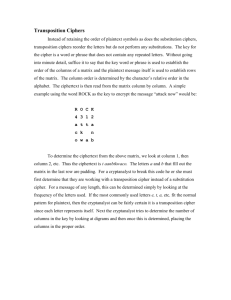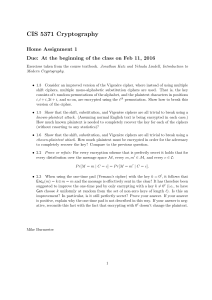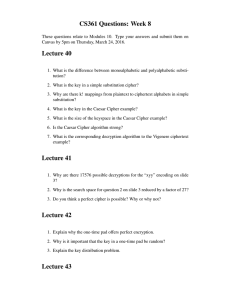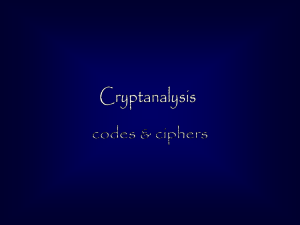Cryptology
advertisement
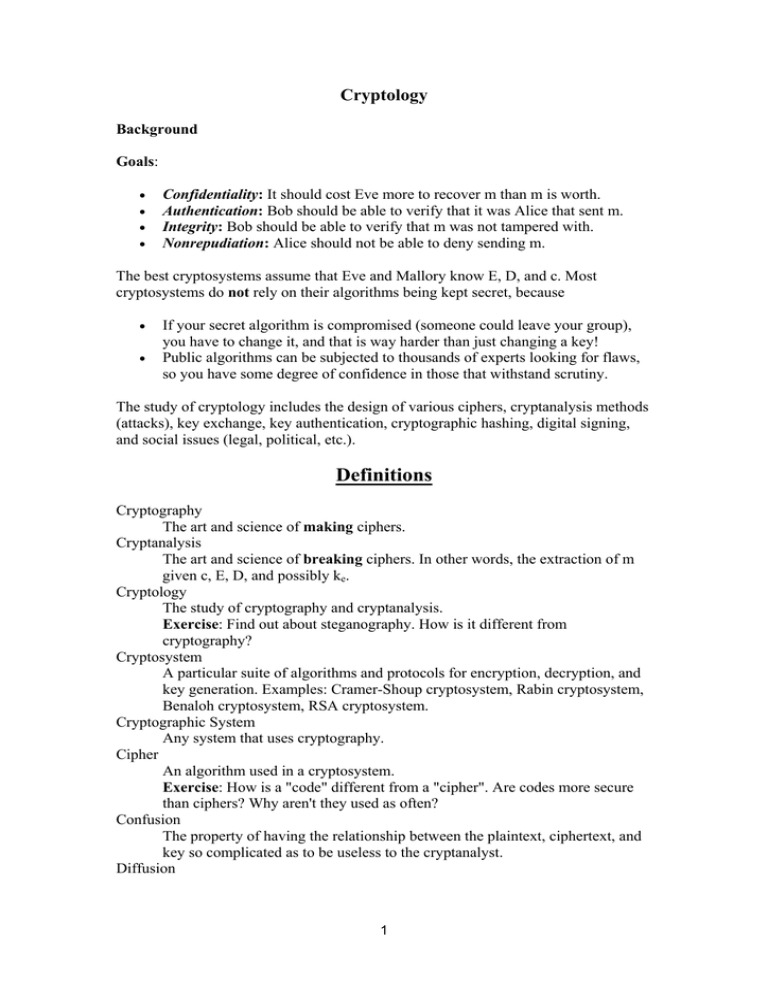
Cryptology
Background
Goals:
•
•
•
•
Confidentiality: It should cost Eve more to recover m than m is worth.
Authentication: Bob should be able to verify that it was Alice that sent m.
Integrity: Bob should be able to verify that m was not tampered with.
Nonrepudiation: Alice should not be able to deny sending m.
The best cryptosystems assume that Eve and Mallory know E, D, and c. Most
cryptosystems do not rely on their algorithms being kept secret, because
•
•
If your secret algorithm is compromised (someone could leave your group),
you have to change it, and that is way harder than just changing a key!
Public algorithms can be subjected to thousands of experts looking for flaws,
so you have some degree of confidence in those that withstand scrutiny.
The study of cryptology includes the design of various ciphers, cryptanalysis methods
(attacks), key exchange, key authentication, cryptographic hashing, digital signing,
and social issues (legal, political, etc.).
Definitions
Cryptography
The art and science of making ciphers.
Cryptanalysis
The art and science of breaking ciphers. In other words, the extraction of m
given c, E, D, and possibly ke.
Cryptology
The study of cryptography and cryptanalysis.
Exercise: Find out about steganography. How is it different from
cryptography?
Cryptosystem
A particular suite of algorithms and protocols for encryption, decryption, and
key generation. Examples: Cramer-Shoup cryptosystem, Rabin cryptosystem,
Benaloh cryptosystem, RSA cryptosystem.
Cryptographic System
Any system that uses cryptography.
Cipher
An algorithm used in a cryptosystem.
Exercise: How is a "code" different from a "cipher". Are codes more secure
than ciphers? Why aren't they used as often?
Confusion
The property of having the relationship between the plaintext, ciphertext, and
key so complicated as to be useless to the cryptanalyst.
Diffusion
1
The property of having statistical patterns in the plaintext spread widely
throughout the ciphertext.
Kinds of Ciphers
Here are some useful categories of ciphers. Note that a particular cipher may belong
to more than one of these categories.
•
•
•
•
•
•
•
•
•
•
•
•
•
•
Classical (a.k.a. manual): A cipher easy enough to be performed by hand,
usually character-based
Modern: Pretty much any cipher that isn't "classical"
Substitution: Each character of the plaintext is replaced with one or more
characters to make the ciphertext
Transposition: Characters in the plaintext are scrambled to form the ciphertext
Monoalphabetic: A substitution cipher in which a character of the plaintext is
always replaced by the same character
Polyalphabetic: A substitution cipher that essentially uses multiple
monoalphabetic substitution mappings
Homophonic: A substitution in which one character can map to one of a set of
characters
Polygraphic: A substitution of blocks of characters for blocks of characters
Periodic: A polyalphabetic cipher in which the replacement scheme "repeats"
Non-periodic: (Self-explanatory if you understand periodic)
Block: Encryption takes place not per character but per "blocks" of characters.
Stream: A cipher operating on a data stream of unknown length, usually
incorporating feedback.
Secret Key: A cipher in which ke and kd are the same or trivially derivable
from one another; requires the parties to meet in secret to exchange the keys
they'll be using. Also called symmetric.
Public Key: A scheme in which everyone's encryption key is publicly known
but their decryption key is kept secret. Also called asymmetric.
NOTE: In the character-based examples below, we'll assume (without any loss of
generality) a 26 symbol alphabet ('A'..'Z').
Secret Key Cryptography
Secret key (a.k.a. symmetric key) ciphers are much faster than public key ciphers, but
key management can be a huge problem.
•
•
•
•
If n people in a group need to communicate, they need n(n−1)/2 keys.
Keys must be distributed securely (in secret).
Keys must be kept safe.
Keys should be changed frequently, which feeds back into the distribution
headache.
2
Caesar Cipher
A completely pathetic and insecure cipher by modern standards. The encryption key
ke is a small integer and kd = ke. To encrypt, add ke to each plaintext character; to
decrypt, subtract.
Example: For k=5, "ATTACKATDAWN" becomes "FYYFHPFYIFBS"
Trivial to crack: just guess ke.
Monoalphabetic Substitution
Instead of simply adding a fixed offset to each character, you can precompute a
"substitution table" by generating a random permutation of your alphabet. For
example:
ABCDEFGHIJKLMNOPQRSTUVWXYZ
MQHPSVJYCURFTBILAKWNGZDOEX
Now "ATTACKATDAWN" is now "MNNMHRMNPMDB".
You don't crack this by guessing the key (there are n! possible keys), but frequency
analysis can crack any monoalphabetic substitution cipher, provided the message is
long enough.
For techniques whose "key" is a permutation, one way to make the key easier to
remember is to pick a phrase, lay out its unique letters, then fill in missing letters in
order. For example, "PREMATURE OPTIMIZATION IS THE ROOT OF ALL
EVIL" yields this substitution mapping:
PREMATUOIZNSHFLVBCDGJKQWXY
Homophonic Substitution
Each plaintext letter maps to one or more symbols in the ciphertext. The number of
targets should be proportional to its frequency (to defeat frequency analysis).
Example:
A
B
C
D
E
F
G
H
I
J
K
L
12 15 36 50 56 70 81 95
51 84
16 44 65
04 06 48 82
01 17 19 34 47 49 58 60 67 77 85 90
13 27
09 28
26 42 53 59 68 71
35 73 76 86 91 96
18
07
29 40 54 87
3
M
N
O
P
Q
R
S
T
U
V
W
X
Y
Z
25 30
21 61 62 69 74 94
02 03 08 10 57 75 93
41 98
97
32 38 43 45 80 83
14 22 39 79 89 99
00 20 23 33 46 52 72 78 88
11 64 66
37
63 92
31
24 55
05
To encrypt, choose randomly among possibilities. Example, one possible encryption
of "ATTACKATDAWN" is
56 78 20 95 65 07 12 72 06 50 92 61
Polyalphabetic Substitution
Polyalphabetic substitution ciphers use multiple substitution alphabets. There are
quite a few ways to do this.
Simple Vigenère
The cipher known as the simple shift Vigenère cipher was not invented by Vigenère at
all... it seems to have been first described by Giovan Battista Bellaso. The key is a
string that you add to the plaintext with modular addition, like in this example (A=0,
B=1, C=2, ..., Z=25):
Plaintext:
TAKEACOPYOFYOURPOLICYTONORMAWILCOXONTHETHIRDFLOOR
Key:
QUARKQUARKQUARKQUARKQUARKQUARKQUARKQUARKQUARKQUA
R
Cipher text:
JUKVKSIPPYVSOLBFILZMONOEYHGANSBWOOYDNHVDXCRUPBIOI
To generate cipher text by hand you can use a code wheel or tabula recta.
This scheme isn't secure since the key repeats. If the key length can be determined,
the cryptanalyst can do multiple frequency analyses (one for each shift value in the
key). Methods for determining key length are the Kaisiski Method and the Friedman
test.
For "binary data" (i.e., a sequence of bits) modular addition base-2 is just a simple xor
. Example:
4
Plaintext: 0110000101010000111101001010101010010000001111101
Key:
0000011100000111000001110000011100000111000001110
Ciphertext: 0110011001010111111100111010110110010111001110011
Auto-Key Vigenère
Vigenère actually created an auto key cipher which is stronger because the key never
repeats. Instead the "key" is made up of the key phrase followed by the plaintext, like
this:
Plaintext:
TAKEACOPYOFYOURPOLICYTONORMAWILCOXONTHETHIRDFLOOR
Key:
QUARKTAKEACOPYOFYOURPOLICYTONORMAWILCOXONTHETHIRD
Cipher text:
JUKVKVOZCOHMDSFUMZCTNHZVQPFOJWCOOTWYVVBHUBYHYSWFU
That one used the plaintext as part of the key. You could also use the cipher text. See
how?
Modern Auto-Key Ciphers
You can still crack autokey Vigenère ciphers by linguistic analysis, because the key
contains text and is thus likely to have high-frequency letters. Modern auto-key
ciphers generate the shift values with a random number generator. The key seeds the
generator.
Exercise: Implement an autokey cipher in Java.
One Time Pad
If the key
•
•
•
is as long as or longer than the message being encoded
is truly randomly generated
is used once and only once
Then you have a provably secure cipher called the one time pad. Your actual
algorithm can use polyalphabetic substitution or even simple xoring the message with
the key, as long as you meet the three criteria above.
The one-time pad can never be cracked. It is a perfect encryption scheme, from a
mathematical perspective, anyway.
Exercise: Why aren't one time pads commonly used, then, given that they are the
most secure ciphers possible?
5
Playfair
This is an example of a poly graphic substitution cipher. It replaces pairs of
characters. The key is a permutation of {A..I,K..Z}, for example:
ZCBML
GDAQE
TUOKH
FSXVN
PIYRW
To encrypt, write out the plaintext (without spaces or punctuation), sticking in an X
between double letters and at the end if necessary to make the text have even length.
Then for each pair of letters:
•
•
•
•
Let (a,b) be the row and column of the first character and (c,d) be the row and
column of the second.
If a ≠ c and b ≠ d then return (a,d)(b,c).
If a = c then return (a,(b+1)%5)(c,(d+1)%5).
If b = d then return ((a+1)%5,b)((c+1)%5,d).
Example: "THEN ATTACK FROM THE EAST" "TH EN AT XT AC KF RO MT
HE XE AS TX" "UT HW GO FO DB TV YK ZK NH NA DX OF".
Decryption runs the rules in reverse. The Play fair cipher is pretty insecure.
Four-square
Encrypts digraphs like play fair, but slightly stronger because it allows for double
letters and doesn't yield reversed cipher text digraphs for reversed plaintext digraphs.
Example
ab cd e
fg hi k
lm nop
qr s t u
vwxyz
GI V EM
LBRT Y
ODAHC
F KNPQ
SUWXZ
PREMA
TUOIZ
NSHFL
VBCDG
KQWXY
abcde
fgh ik
lmnop
qrs tu
vwx y z
For which "THEN ATTACK FROM THE EAST" "TH EN AT TA CK FR OM TH
EE AS TX" "NI VL EV FM MO BV DF NI MA VV NX".
Okay, so slightly stronger than Playfair but so what! Computers can crack these things
in seconds, or perhaps minutes (given enough ciphertext).
6
Simple Block Transposition
The simplest transposition cipher breaks up the message into blocks of size n, then
scrambles each block according to a permutation of (1..n).
Example: For the key (4,1,6,3,2,5) the message "GETTHATHEALTHINSPECTOR"
becomes "TGATEHATTEHLSHENIPRCOT".
Columnar Transposition
Write out the message row by row in a grid, then read it out in columns. Totally
insecure. The key is just the number of rows. Guess it.
Rail Fence
The rail fence is no better than the last one, just funkier. The key is the number of
"rails" on which you write the plaintext in an up and down fashion, generating the
ciphertext by reading one rail at a time.
Example: To encode "fill out and file a WS2475 form" on 4 rails:
f t l 4 m
i ua ie 27 r
lo nf as 5o
l d w f
you then read out the ciphertext "ftl4miuaie27rlonfas5oldwf". This is trivial to crack.
Just guess k.
Combining Substitution and Transposition
Transposition alone is very weak; substitution is weak; combining them is better. You
can mix a lot of the classic substitution ciphers with various transpositions, or use
some special combination ciphers like bifid. Also, most of the famous rotor machines
and modern ciphers use this combination; in fact they apply these transformations
many times.
Bifid
This one substitutes letters with their coordinates in a grid and does a columnar
transposition on the coordinates. Example:
ZCBML
GDAQE
TUOKH
FSXVN
PIYRW
Write the (row, column) coordinates under each letter of the plaintext (e.g., "A" is at
row 1, column 2; "T" is at row 2, column 0, etc.):
7
ATTACKATDAWN
122102121143
200213201244
Then read out in rows, group by twos and look up the ciphertext letters
122102121143200213201244
AUBADRTBQTAW
Trifid
Like Bifid, but on a cube. Example:
ZCB
GDA
TUO
MLF VNP
QEX IRW
KHS Y.J
To encrypt, first write the coordinates
ATTACKATDAWN
000001000022
122102121110
200210201221
000001000022122102121110200210201221
Z C Z O S F H Q V I N .
Enigma
The Enigma was the famous German rotor machine from World War II (actually a
family of machines). Most versions implemented a polyalphabetic substitution cipher
with a period of 16900 plus a plugboard for scrambling (transposition). The "key"
consisted of the order of the rotors, the starting position of each roter, the ring
settings, and the plugboard settings (about 1.6 × 1020 possibilities). There was a new
key each day (more or less) prepublished in codebooks.
The Allies were able to crack it thanks to some weaknesses in its design...
•
•
No letter would encrypt to itself
Self-reciprocity meant that there were fewer scrambler setup possibilities
...but more importantly, many weakness in the way it was used...
•
•
It was really easy to find cribs. Most messages began with a weather report.
Early on, message keys appeared twice in succession.
...and by obtaining codebooks from captured vessels.
You can read about how the Enigma was broken from the NSA, and from Wikipedia.
Modern Cryptographic Methods
8
Now that we have Shannon's information theory, very powerful computers, and
centuries of theory and practice behind us, most modern techniques
•
•
•
•
operate on bit strings, not character strings
are careful to completely mask patterns and redundancies in the plaintext
use random keys (that can be reused, too)
ensure that very slight changes in the plaintext affect a large portion of the
ciphertext (and vice versa). This is called the Avalanche Effect.
In addition, it's nice if the cipher is
•
•
efficient
fault-tolerant
Most ciphers are either block ciphers or stream ciphers. Block ciphers require padding
and can operate in different modes (See Schnier's book or the Wikipedia article:
•
•
•
•
•
•
•
•
ECB — Electronic Codebook
CBC — Cipher Block Chaining
CFB — Cipher Feedback
OFB — Output Feedback
CTR — Counter
BC — Block Chaining
PCBC — Propagating Cipher Block Chaining
CBCC — Cipher Block Chaining with Checksum
9

